Digitization in Utilities: Enhancing Efficiency and Resilience Today

Kristian Storm
Co-Founder & CEOIntroduction
Digitization in utilities is rapidly changing how utilities, energy providers, municipalities, and stakeholders manage infrastructure, reduce costs, and ensure reliable service for their communities and businesses. Distributed energy resources are becoming crucial in enhancing grid reliability and supporting the transition to smarter renewable energy management.
At Waltero, we’ve seen firsthand how harnessing digital technologies and solutions can significantly optimize utility asset management, improve decision-making, strengthen grid resilience, and reduce energy costs.
Below, we’ll discuss the key drivers behind this digital transformation, showcase real-world examples, and highlight strategies for improving customer experience. Additionally, how to modernize and facilitate utility asset management to overcome common challenges.
What is Digitization in Utilities?
Digitization in utilities refers to the shift from manual, analog processes to digital systems that enable real-time data collection, analysis, and automation across the energy value chain. It involves integrating technologies such as the smart meter, IoT devices, and advanced analytics to enhance how utilities monitor, manage, and optimize their operations and energy transition.
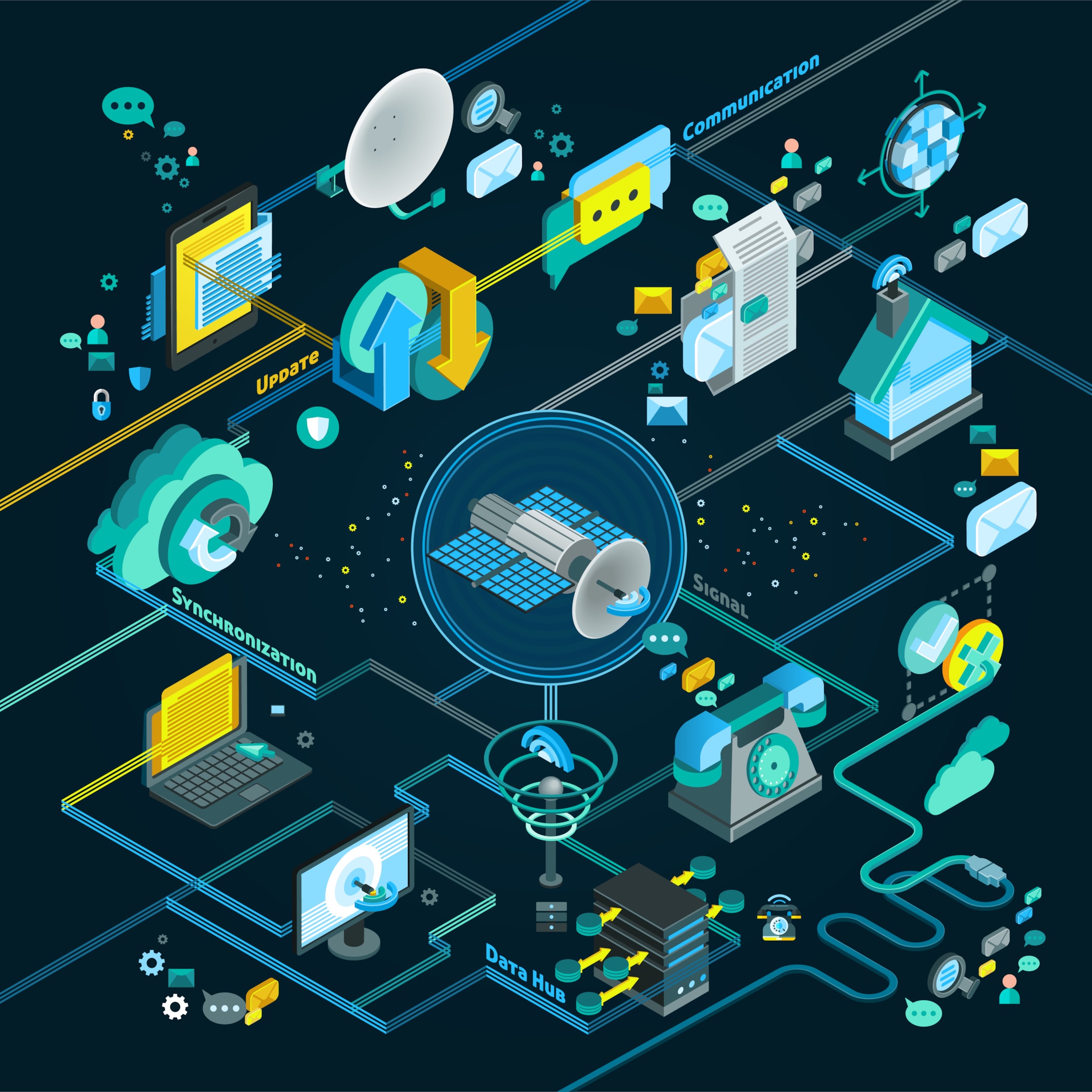
As the energy landscape evolves, utilities face growing challenges: aging infrastructure, rising demand, decentralized energy sources, increasing pressure to meet sustainability targets, and reducing carbon footprint. Traditional systems are no longer equipped to handle this complexity efficiently. Digitization provides the tools to adapt, offering deeper grid visibility, faster response times, and better resource planning.
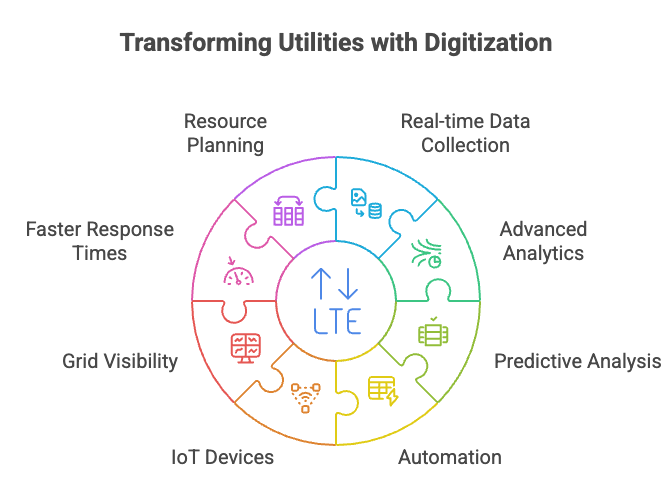
By embracing digitization, utilities can proactively address issues like power outages, energy waste, extensive energy usage, and elevated energy costs. It enables smarter decision-making, predictive maintenance, and streamlined operations—all of which are essential for building a more resilient and sustainable energy system. In a future defined by volatility and rapid innovation and change, digitization isn’t just an upgrade—it’s a strategic necessity to boost efficiency and renewable energy.
Key Principles of Digital Transformation
Digital transformation is a complex and multifaceted process that requires a deep understanding of its key principles.

These principles serve as a foundation for a successful digital transformation strategy, helping the utility sector and the energy industry navigate the challenges of modernizing their operations, energy transition, and grid resiliency.
Customer-Centricity: At the heart of any successful digital transformation strategy is a focus on the customer. Utilities must prioritize creating a seamless and personalized customer experience that meets evolving needs. By leveraging digital technologies, utilities can enhance customer satisfaction and build stronger relationships.
Data-Driven Decision-Making: In the digital age, data is a critical asset. Utilities should harness advanced analytics and digital innovations to make informed decisions that drive impactful business outcomes and gain a competitive advantage. By analyzing data from various sources, utilities can optimize operations, predict maintenance needs, and improve service delivery.
Collaboration and Partnerships: Digital transformation is not a solo endeavor. It requires collaboration and partnerships between utilities, technology providers, and other stakeholders. By fostering a culture of collaboration, utilities can drive innovation and achieve greater success in their digital initiatives.
Agility and Adaptability: The digital landscape is constantly evolving, and utilities must be agile and adaptable to keep pace. This means being able to quickly respond to changing market conditions and customer needs. An agile approach allows utilities to implement new technologies and processes more efficiently.
Cybersecurity: As utilities become more digitized, the risk of cyber threats increases. Prioritizing cybersecurity is essential to protect systems and data from potential breaches. Implementing robust cybersecurity measures ensures the integrity and reliability of digital infrastructure.
The utility industry is undergoing a significant shift toward data-driven insights. Digital transformation allows utilities to leverage data analytics and transform digital systems, striving towards operational efficiency.
Overcoming Common Challenges
Digitization is the first step in modernizing utilities, replacing manual processes with digital systems to improve data access and operational control and remain aligned with regulatory compliance measures.

This forms the foundation for digitizing utilities, where technology is used not just to optimize tasks but to reshape how utilities operate, make decisions, and deliver value. Together, they enable smarter, more efficient, and future-ready energy systems.
1. Aging Infrastructure
A primary concern is aging pipelines prone to leaks and bursts. Many utilities lose up to 20–30% of their treated water before it reaches customers. Similarly, aging infrastructure contributes to frequent power outages, disproportionately affecting areas with high energy consumption rates. By incorporating digital transformation strategies and advancements in grid technology, operators can pinpoint leaks more quickly, streamline repairs, reduce water loss significantly, and enhance efficiency and grid resilience to ensure reliable electricity delivery even during extreme weather and high-demand scenarios.
2. Regulatory and Compliance Pressures
Public safety standards and environmental regulations are more stringent than ever. Digitization gives utilities the tools to collect, store, and analyze quality data in near real-time, making compliance tracking and reporting more efficient. By automating critical metrics, operators minimize manual data entry and reduce the risk of errors or oversights.
Today’s consumers want more reliability, control, and safety within all industries, from gas, electricity, and water. Advanced metering smart devices, embedded with machine learning and AI-driven analytics, can detect leaks, predict outages, and integrate distributed energy resources (such as solar or battery storage) more effectively, significantly increasing sustainability, customer loyalty, and alignment with compliance systems.
3. Workforce Changes
In the evolving utility landscape, the future workforce must be supported by intelligent systems that capture, retain, and deliver expertise at scale. Digital tools powered by AI and machine learning can streamline training, automate repetitive tasks, and provide real-time guidance, reducing the learning curve for new employees. To make this possible, it’s vital to engage experienced workers in designing digital workflows that can serve as a foundation for AI training and knowledge transfer.
A wave of retirements among experienced professionals creates knowledge gaps. At Waltero, we believe in using digital platforms to capture institutional expertise and empower the next generation of utility workers with intuitive interfaces and data-driven support. This transition helps preserve know-how while cutting down on repetitive, manual tasks.
Digitizing operations isn’t just about automation—it’s about ensuring the right information reaches the right people at the right time. From fieldwork to control centers, digital systems enhance communication, enable mobile access to critical data, and foster collaboration across teams. As utilities face growing technical demands, attracting skilled tech talent and building digital acumen across the workforce becomes essential. With the right hardware and software in hand, every worker can confidently contribute to a smarter, more resilient energy future.
How Waltero is Facilitating Distributed Energy Resources
Waltero’s integrated W-Solution software consolidates data through the hardware, the smart meter device, then transmits data and interprets it using cloud computing and artificial intelligence, providing near real-time visibility into your entire network. By leveraging distributed energy resources, our platform enhances grid reliability and supports community resilience. For instance, if there’s a sudden pressure drop or a surge in flow, our platform immediately flags the issue so technicians can take swift action.
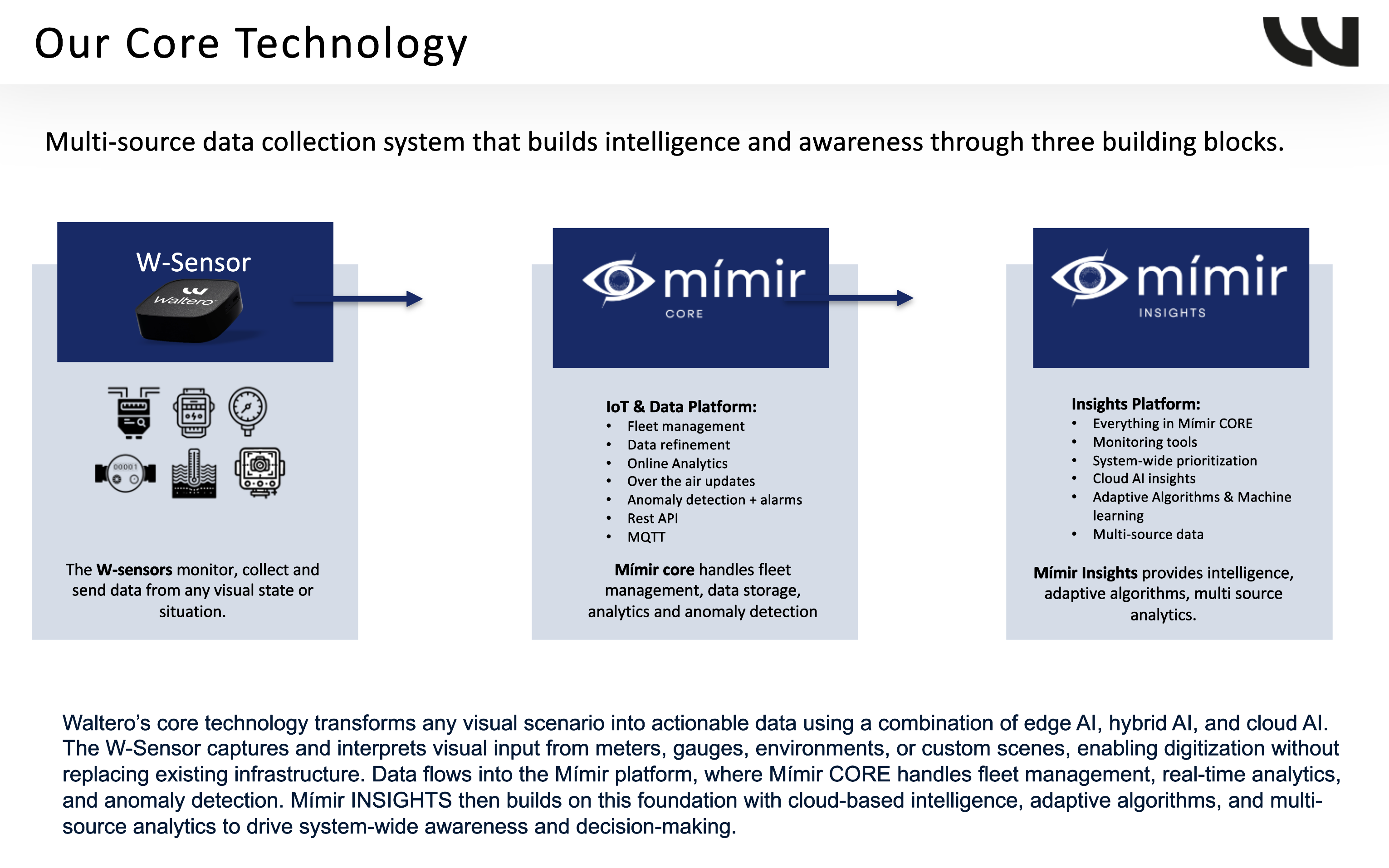
Digitization is revolutionizing energy resources, enhancing efficiency, resilience, and cost savings. At Waltero, we use AI, smart sensors, and cloud tech to optimize water and energy management. This article highlights key trends and strategies for modernizing utilities in a rapidly evolving landscape.
Predictive Maintenance with Advanced Analytics
Our Mímir cloud platform harnesses the power of AI, IoT, machine learning, and computer vision to bring predictive maintenance to an entirely new level. By continuously analyzing data from sensors and connected devices, Mímir identifies subtle patterns and early warning signals that often precede equipment failures, whether it’s a pump, pipeline, or distribution node for utilities, as well as for the energy industry.
Instead of relying on routine checkups or reactive fixes, utilities can schedule maintenance precisely when it’s needed—just before a failure is likely to occur. This proactive approach dramatically reduces unplanned downtime, minimizes costly emergency repairs, and eliminates time lost on repetitive manual inspections. The result is a more efficient, responsive, and resilient utility operation.
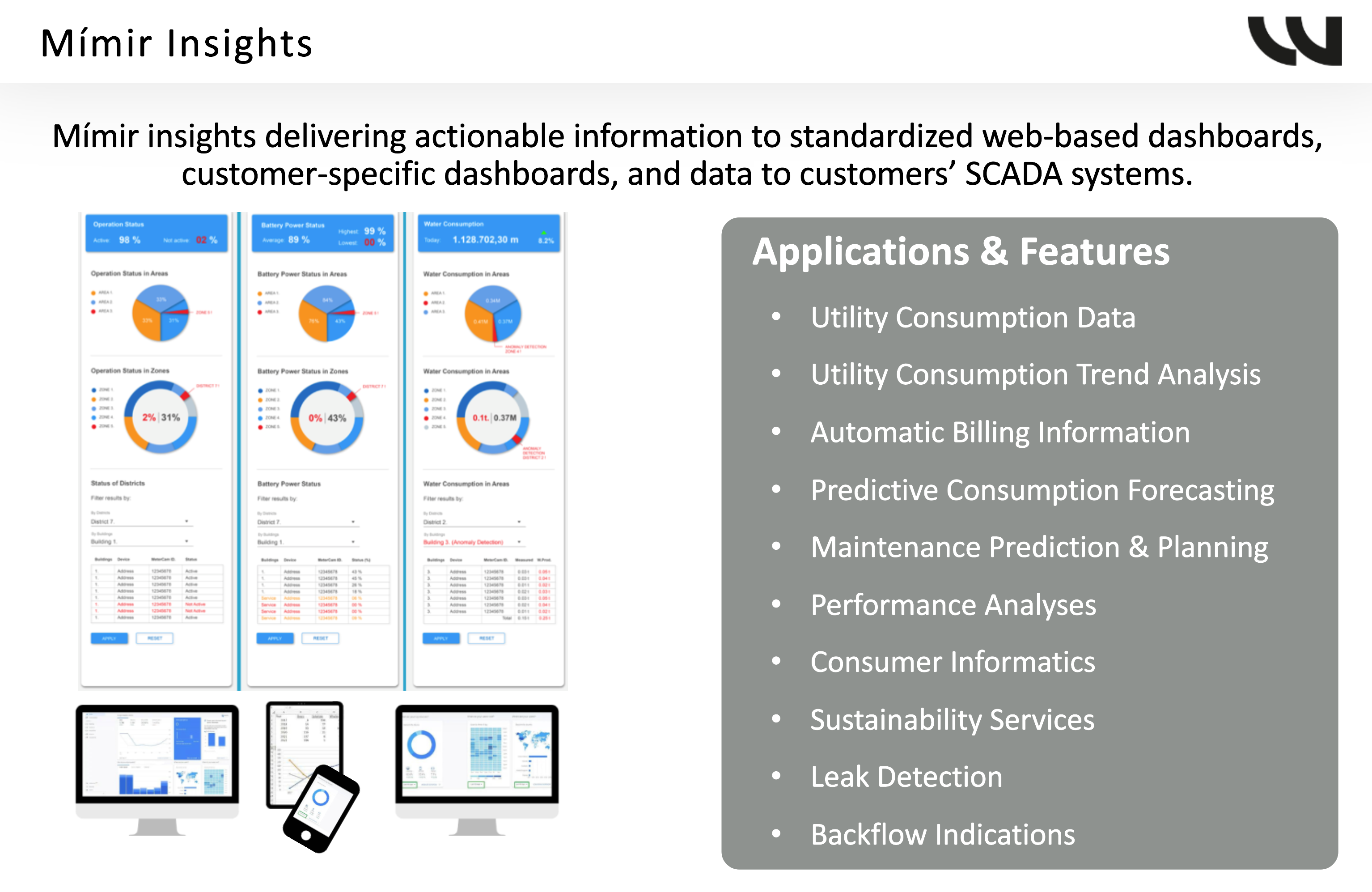
Beyond asset health, Mímir also detects unusual consumption behavior, such as sudden spikes or drops in usage, potentially pointing to leaks, inefficiencies, or tampering. Advanced analytics provide real-time insights and forecasts at every level—from grid-wide performance to individual user patterns. This empowers utilities to make smarter operational decisions, optimize energy distribution, and enhance customer service with actionable, data-driven intelligence.
In essence, Mímir Inights turns data into foresight, helping utilities anticipate problems, adapt faster, and operate smarter.
Cost-Effective Upgrades
In the age of digital transformation, upgrading utility infrastructure doesn’t have to mean a complete overhaul. Waltero’s approach to cost-effective modernization is built around smart, strategic investments that deliver value without disrupting operations or exhausting budgets. Our Edge AI device, the W-Sensor, is designed for plug-and-play deployment, allowing it to integrate with existing legacy systems seamlessly. These devices can be updated on intervals and scaled as needed, making it easy for utilities to prioritize urgent challenges while maintaining long-term flexibility.
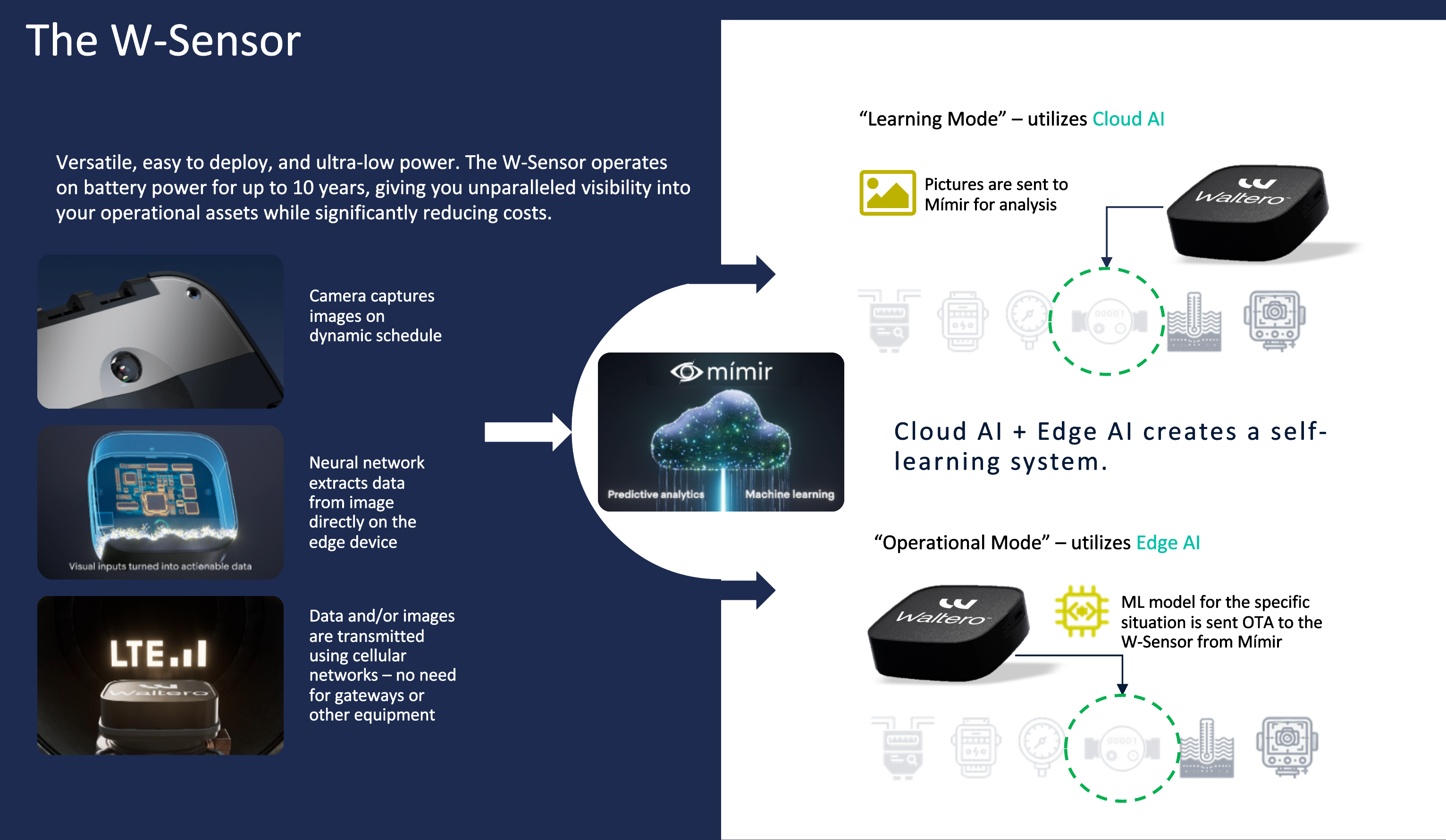
One of the key advantages lies in scalability. Whether you’re upgrading a single facility or rolling out across multiple sites, Waltero’s modular W-Solution grows with your needs, allowing phased implementation that aligns with budget cycles and operational priorities, especially for the utility sector. Additionally, our remote monitoring capabilities significantly reduce the need for on-site interventions. Through real-time insights and system-wide visibility, utilities can monitor performance, detect anomalies, and respond to issues without costly field visits, driving down maintenance costs and increasing operational efficiency.
By focusing on incremental upgrades backed by intelligent monitoring, Waltero empowers utilities to transition to smarter, more resilient systems—at a pace and cost that’s both practical and impactful.
Improving Customer Experience through Digitization
Digitization is a critical component of improving customer experience in utilities. By leveraging digital technologies, utilities can create a seamless and personalized customer experience that meets evolving needs.
Digital Engagement: Engaging with customers through digital channels such as social media, email, and mobile apps can enhance communication and build stronger relationships. Digital engagement allows utilities to provide timely updates and address customer concerns more effectively.
Personalization: Using data analytics, utilities can personalize the customer experience by tailoring services and communications to individual needs. Personalization helps utilities meet customer expectations and improve overall satisfaction.
Self-Service: Providing self-service options empowers customers to manage their accounts and access information independently. Self-service portals and mobile apps offer convenience and flexibility, enhancing the customer experience.
Real-Time Information: Utilities should provide real-time information about outages, maintenance, and other issues. Real-time updates keep customers informed and reduce uncertainty, leading to higher levels of trust and satisfaction.
Feedback Mechanisms: Establishing feedback mechanisms allows utilities to collect customer feedback and make continuous improvements. By listening to customer input, utilities can identify areas for enhancement and deliver a better customer experience.
By following these key principles, software development and implementation considerations, and customer experience improvement strategies, utilities can drive successful digital transformation and create a better future for their customers and stakeholders.
Software Development and Implementation in Utilities
Software development and implementation are necessary for digital transformation in utilities. The utilities industry and energy industry should focus on developing and implementing software solutions that meet their specific needs and requirements.
Scalability: As utilities grow and evolve, their software solutions must be able to scale accordingly. Scalable software ensures that utilities can handle increasing data volumes and user demands without compromising performance.
Interoperability: Utilities often operate with a mix of legacy and modern systems. Software solutions should be interoperable with existing technologies to ensure seamless integration and data sharing. This interoperability is crucial for leveraging digital technologies effectively.
Security: Protecting sensitive data and systems is paramount. Software solutions should prioritize cybersecurity and data protection to safeguard against potential threats. Robust security measures help maintain trust and reliability in digital operations.
User Experience: A seamless and intuitive user experience is essential for both customers and employees. Software solutions should be designed with the end-user in mind, ensuring ease of use and accessibility. Enhancing the user experience can lead to higher adoption rates and improved customer satisfaction.
Integration: Effective software solutions should integrate with existing systems and technologies to drive business value. Integration enables utilities to leverage data from various sources, streamline operations, and enhance decision-making processes.
With the help of the W-Solution, utilities can confidently advance their digital strategies while delivering better service, efficiency, and long-term value to both customers and businesses.
Case Studies and Success Stories
Cincinnati MSD: A Digital Twin Victory
The Metropolitan Sewer District of Greater Cincinnati embraced digital transformation and used a sophisticated digital twin to optimize its sewer network. Through real-time controls and simulation, they identified ways to reduce overflows without huge infrastructure builds. This approach of Digital Twin technology helped the city reduce combined sewer overflow, saving 247 million gallons and $38 million in capital project work in capital expenses, and protected local waterways.
VA SYD: Adopting Predictive Cleaning
A Swedish water utility installed new technologies of AI-based sensors on intake screens, enabling proactive maintenance and fewer blockages. By analyzing historical data, the system automatically scheduled cleaning just before capacity declined. This strategy helped the utility cut operational costs by 70%—proof of how advanced utility software translates directly to ROI. Defining key performance indicators (KPIs) for each project is crucial for measuring the success of such digital transformation initiatives.
ROI Benefits of Digitization in Utilities
Integrating advanced technologies into utility business models is no longer optional, it’s a strategic imperative. By embedding digital tools into core operations, utilities can shift from reactive service providers to proactive, data-driven organizations, especially for electric utilities. This transformation enables smarter asset management, real-time decision-making, and personalized customer engagement.
Reduced Resource Loss: By curbing leaks, utilities can reach optimal resource management and allocation while lowering energy consumption and production, besides to treatment costs.
Energy Savings: Data-driven insights help optimize pump scheduling, often a major source of leaks, reaching optimal operational efficiency and sustainability.
Extended Asset Life: Predictive maintenance and real-time remote monitoring minimize severe breakdowns, extending the utility pipelines and the equipment’s longevity.
Improved Customer Satisfaction: Faster response times and accurate billing foster trust among consumers and improve efficiency.
Enhanced Compliance: Automated data collection streamlines regulatory reporting and avoids costly penalties.
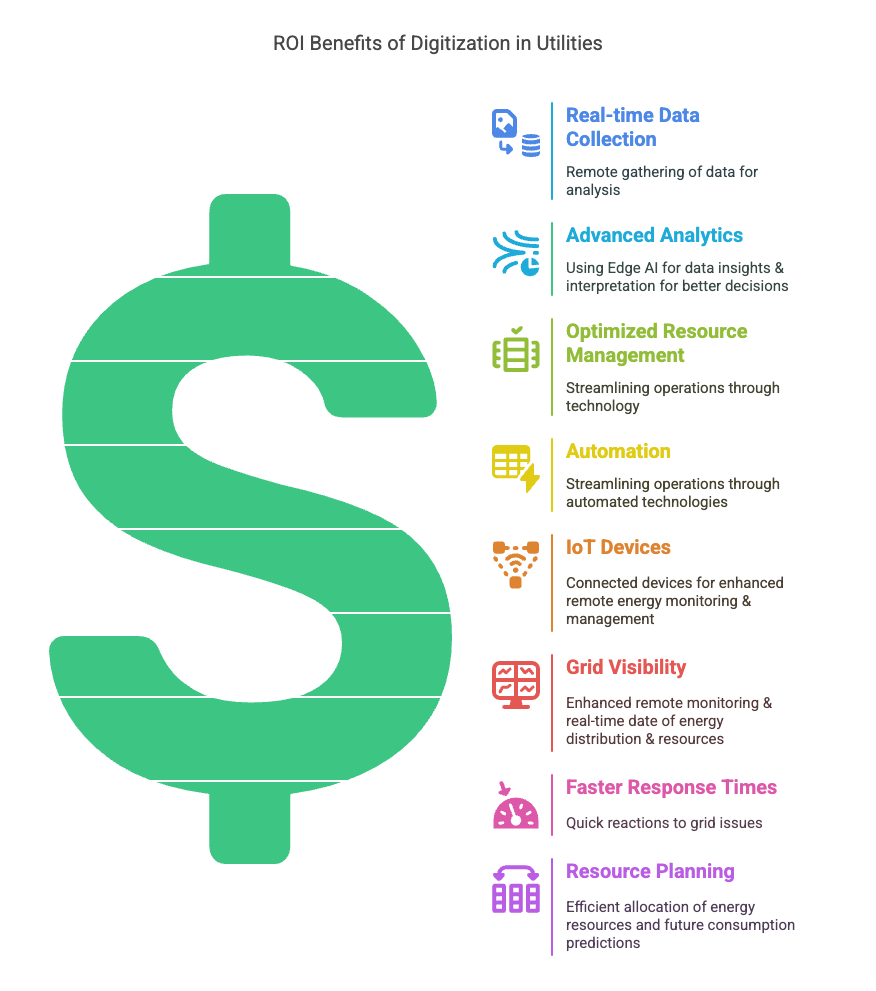
Digital solutions surely open new revenue streams through value-added digital services and improved energy usage offerings. As business models evolve, digital data becomes a catalyst for agility, resilience, and long-term growth, allowing utilities to adapt swiftly to market shifts, regulatory demands, and emerging technologies while delivering greater value to both the grid and their customers.
Looking Ahead: Improved Energy Transition for Greater Grid Reliability
As we continue to invest in new smart operating models, modernize energy infrastructure, the future of utilities will revolve around integrated digital solutions, widespread use of IoT smart meter sensors, machine learning, and data analytics for enhanced AI-based decision-making.
The future anticipates:
Fully Automated Operations: Edge devices will increasingly handle local tasks independently, optimizing pressure or chemical dosing in near real-time.
Expanded Use of Digital Twins: Operators will simulate network changes and upgrades in a virtual environment, ensuring data-driven capital planning.
The shift toward cleaner, smarter energy systems is accelerating, and digital transformation is playing a critical role in enabling a smoother energy transition. By integrating renewable energy sources, deploying IoT-enabled infrastructure, and leveraging advanced data analytics, utilities can better manage the complexity of a decentralized energy landscape. This transition not only supports sustainability goals but also enhances system flexibility and responsiveness.
At the same time, grid reliability becomes even more essential. Smart meters, remote monitoring in real-time, and machine learning will empower utilities to detect and respond to faults faster, balance loads more effectively, and prevent outages before they occur. With fully automated operations, expanded use of digital twins, and strengthened cybersecurity, utilities are building a grid that’s not only cleaner but smarter, stronger, and more reliable for a sustainable future.
Conclusion
Digitization in utilities is no longer a luxury—it’s an essential strategy for improving reliability, meeting regulatory demands, and enhancing operational efficiency.
At Waltero, we’re committed to helping the utility industry whether it’s for gas, water, or electricity to reach digital transformation by adopting the right blend of IoT sensors, AI-driven analytics, and remote monitoring smart meter technologies to stay ahead of growing challenges and provide a smooth energy transition and reduce wasted energy consumption.
Embark now on our journey to help organizations embrace digital transformation by exploring our offerings. Apply for Waltero’s Exploratory Kit – Smart Metering Technology to see how a pilot program could revolutionize your utility’s approach.



